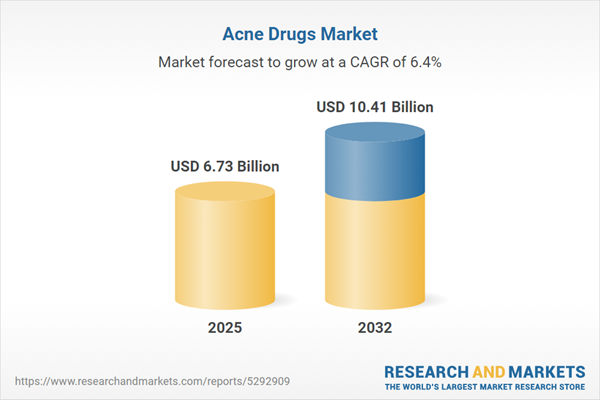Speak directly to the analyst to clarify any post sales queries you may have.
The acne drugs market is evolving quickly as breakthroughs in therapeutics, regulation, and supply chain management reshape opportunities for industry leaders. Senior pharmaceutical executives, healthcare operators, and strategic investors are rethinking their approach to capitalize on changing patient and market dynamics across regions.
Market Snapshot: Acne Drugs Market Outlook
The acne drugs market expanded from USD 6.32 billion in 2024 to USD 6.73 billion in 2025, with projected compound annual growth at 6.43% culminating in USD 10.41 billion by 2032. Market momentum is supported by consistent acne prevalence worldwide and increased demand for therapies that balance safety, effectiveness, and patient comfort. Recent innovation focuses on advanced delivery methods, combination therapies, and integrated care approaches—each responding to tighter regulatory requirements and shifting patient expectations. As these trends gather pace, manufacturers and investors are prioritizing innovation and speed to market while navigating a changing compliance landscape.
Scope & Segmentation of the Acne Drugs Market
- Drug Types: The market is segmented by hormonal agents, oral antibiotics, oral retinoids, topical antibiotics—including clindamycin and erythromycin—and topical retinoids such as adapalene, tazarotene, and tretinoin.
- Treatment Categories: Both over-the-counter and prescription drug segments are tailored to varying levels of clinical oversight and patient self-management.
- Acne Types: Treatments are aligned with mild, moderate, and severe forms, each requiring specific protocols for therapeutic intervention.
- Distribution Channels: Key channels include hospital pharmacies, online pharmacies, and retail outlets covering both chain and independent locations.
- Patient Profiles: Adolescents, adults, and pediatric patients present distinct therapy adherence patterns, influencing formulation, dosing, and support needs.
- End-Users: The sector serves cosmetic clinics and med spas, dermatologists, hospitals, outpatient centers, and direct consumers with segment-specific product strategies.
- Geographic Segmentation: Analysis encompasses North America, Latin America, Europe, the Middle East, Africa, and Asia-Pacific. Country-level data is provided for markets such as China, India, Japan, Australia, and South Korea.
- Company Coverage: The research reviews major players including Galderma Laboratories, Bayer, Johnson & Johnson, Bausch Health, GlaxoSmithKline, Sun Pharma, Teva, AbbVie, Pfizer, and Novartis.
Key Takeaways for Decision-Makers
- Emerging therapy options, from precision medicine to new molecular targets and advanced delivery systems, are altering clinical outcomes and supporting differentiated patient experiences.
- Digital health innovations, such as telemedicine and virtual care, significantly enhance patient adherence and brand positioning, making digital engagement a critical part of commercial strategy.
- Divergent regional reimbursement mechanisms and regulatory frameworks create different entry and growth pathways, while local infrastructure and harmonization efforts influence adoption rates and competitiveness.
- Strategic partnerships between global pharmaceutical firms, biotechnology companies, and contract development and manufacturing organizations accelerate the drug development pipeline and drive market growth.
- Supply chain resilience, enabled by diversified sourcing, regional production, and inventory management, supports manufacturers facing fluctuating geopolitical and tariff pressures.
- Targeted marketing and value positioning, shaped by segmenting patient types and treatment approaches, help companies penetrate key growth pockets and adapt offerings efficiently.
Tariff Impact and Strategic Sourcing
Recent changes in US tariffs on acne drug intermediates and finished products have created complex supply chain challenges. Manufacturers have responded by diversifying sourcing regions and increasing local synthesis capacity to better manage cost and sustain reliable supply. Large organizations typically have the resources to absorb these operational pressures, while smaller firms leverage contract manufacturing and partnerships to maintain competitiveness. Across the sector, a focus on supply chain agility and coordinated regulatory advocacy is shaping strategies to preserve access and price stability for acne therapies.
Methodology & Data Sources
Findings are based on expert interviews, primary industry research, and analysis of peer-reviewed articles, regulatory filings, clinical trial outcomes, and proprietary databases. This multi-source approach is enhanced by advanced analytics, data triangulation, and scenario modeling, ensuring robust, actionable insights for market participants.
Why This Report Matters
- Empowers senior leaders with essential evidence to support investment planning, portfolio optimization, and M&A initiatives in the acne drugs sector.
- Guides executives navigating new supply chain dynamics, evolving tariffs, and complex regulatory trends to maintain operational resilience and expand market access.
- Equips organizations with the intelligence to synchronize research, commercial tactics, and stakeholder engagement to shifting global and segment-specific demands.
Conclusion
The acne drugs market is shaped by scientific advancements, policy evolution, and distinct patient requirements. Informed and flexible strategies supported by deep industry intelligence will enable stakeholders to capture growth amid ongoing change.
Additional Product Information:
- Purchase of this report includes 1 year online access with quarterly updates.
- This report can be updated on request. Please contact our Customer Experience team using the Ask a Question widget on our website.
Table of Contents
3. Executive Summary
4. Market Overview
7. Cumulative Impact of Artificial Intelligence 2025
List of Figures
Samples

LOADING...
Companies Mentioned
The key companies profiled in this Acne Drugs market report include:- Galderma Laboratories, L.P.
- Bayer Aktiengesellschaft
- Johnson & Johnson Services, Inc.
- Bausch Health Companies Inc.
- GlaxoSmithKline plc
- Sun Pharmaceutical Industries Limited
- Teva Pharmaceutical Industries Limited
- AbbVie Inc.
- Pfizer Inc.
- Novartis AG
Table Information
| Report Attribute | Details |
|---|---|
| No. of Pages | 183 |
| Published | October 2025 |
| Forecast Period | 2025 - 2032 |
| Estimated Market Value ( USD | $ 6.73 Billion |
| Forecasted Market Value ( USD | $ 10.41 Billion |
| Compound Annual Growth Rate | 6.4% |
| Regions Covered | Global |
| No. of Companies Mentioned | 11 |









